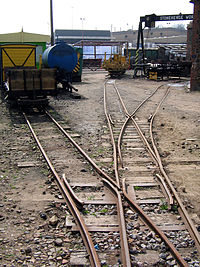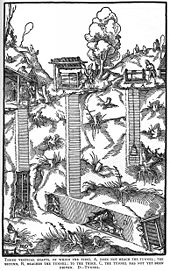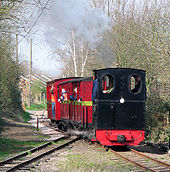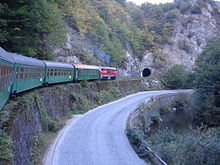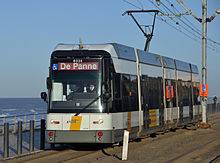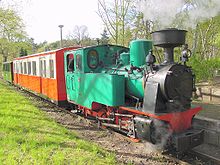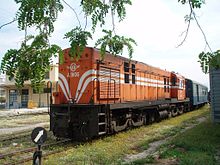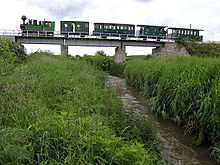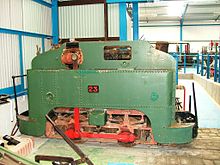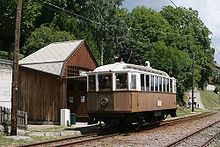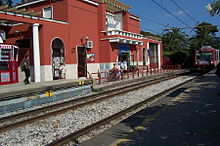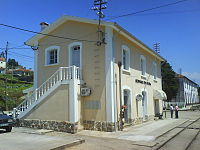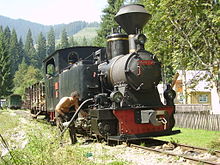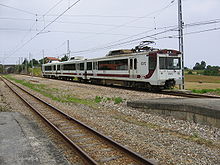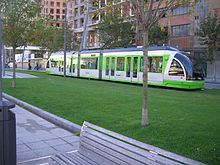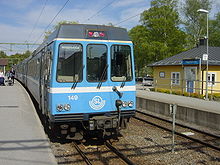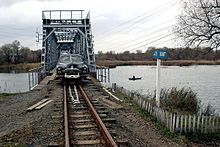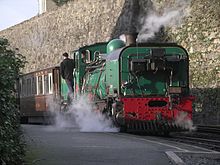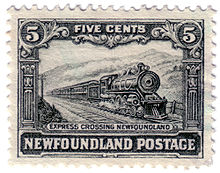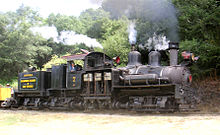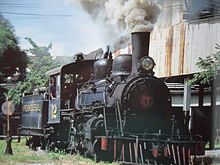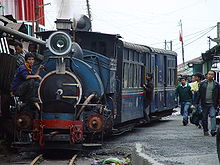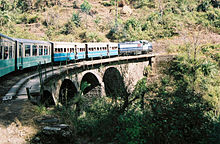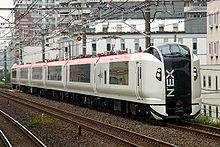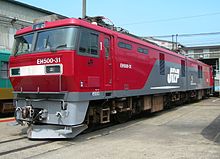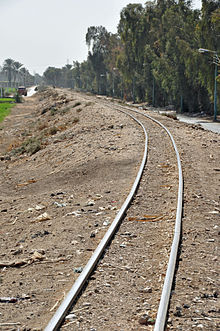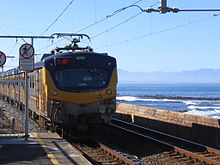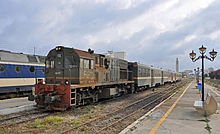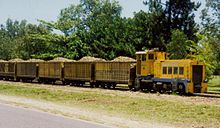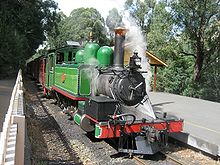- Narrow gauge railway
-
Track gauge by size Broad gauge Standard gauge Narrow gauge Minimum gauge List of rail gauges Break-of-gauge Dual gauge Gauge conversion Track Tramway track A narrow gauge railway (or narrow gauge railroad) is a railway that has a track gauge narrower than the 1,435 mm (4 ft 8 1⁄2 in) of standard gauge railways. Most existing narrow gauge railways have gauges of between 2 ft (610 mm) and 3 ft 6 in (1,067 mm).
Overview
 A train at Bad Bubendorf station on the 750 mm (2 ft 5 1⁄2 in) gauge Waldenburgerbahn between Liestal and Waldenburg in Switzerland [1].
A train at Bad Bubendorf station on the 750 mm (2 ft 5 1⁄2 in) gauge Waldenburgerbahn between Liestal and Waldenburg in Switzerland [1].
Since narrow gauge railways are usually built with smaller radius curves, smaller structure gauges, lighter rails, etc., they can be substantially cheaper to build, equip, and operate than standard gauge or broad gauge railways, particularly in mountainous or difficult terrain. The lower costs of narrow gauge railways mean they are often built to serve industries and communities where the traffic potential would not justify the cost of building a standard or broad gauge line.
Narrow gauge railways also have specialized use in mines and other environments where a very small structure gauge makes a very small loading gauge necessary.
On the other hand, standard gauge or broad gauge railways generally have a greater haulage capacity and allow greater speeds than narrow gauge systems.
Historically, many narrow gauge railways were built as part of specific industrial enterprises and were primarily industrial railways rather than general carriers. Some common uses for these industrial narrow gauge railways were mining, logging, construction, tunnelling, quarrying, and the conveying of agricultural products. Extensive narrow gauge networks were constructed in many parts of the world for these purposes. For example, mountain logging operations in the 19th century often used narrow gauge railways to transport logs from mill sites to market. Trench railways on the western front in World War I were a short-lived military application. Significant sugarcane railways still operate in Cuba, Fiji, Java, the Philippines and in Queensland in Australia. Narrow gauge railway equipment remains in common use for the construction of tunnels.
Narrow gauge railways also have more general applications. Non-industrial narrow gauge mountain railways are or were common in the Rocky Mountains of the United States and the Pacific Cordillera of Canada, in Mexico, Switzerland, the former Yugoslavia, Greece, India, and Costa Rica. In South Africa the "Cape gauge" of 3 ft 6 in (1,067 mm) is the most common gauge. In India, the narrow gauge system is slowly being converted to broad gauge, although some of India's most famous railways, the Darjeeling Himalayan Railway and Kalka-Shimla Railway are both narrow gauge. All 1,000 mm (3 ft 3 3⁄8 in) (metre gauge) railways in India are being converted to 5 ft 6 in (1,676 mm) (broad gauge) under the Unigauge project.
History of narrow gauge railways
The earliest recorded railway is shown in the De re metallica of 1556, which shows a mine in Bohemia with a railway of approximately 2 ft (610 mm) gauge. During the 16th century railways were mainly restricted to hand-pushed narrow gauge lines in mines throughout Europe. During the 17th century mine railways were extended to provide transportation above ground. These lines were industrial, connecting mines with nearby transportation points, usually canals or other waterways. These railways were usually built to the same narrow gauge as the mine railways from which they developed.[1]
Extensive narrow gauge railway systems served the front-line trenches of both sides in World War I. After the end of the war the surplus equipment from these created a small boom in narrow gauge railway building in Europe.
Advantages of narrow gauge
Narrow gauge railways usually cost less to build because they are usually lighter in construction, using smaller cars and locomotives (smaller loading gauge) as well as smaller bridges, smaller tunnels (smaller structure gauge) and tighter curves. Narrow gauge is thus often used in mountainous terrain, where the savings in civil engineering work can be substantial. It is also used in sparsely populated areas where the potential demand is too low for broader gauge railways to be economically viable. This is the case in some of Australia and most of Southern Africa, where extremely poor soils have led to population densities too low for standard gauge to be viable.
There are many narrow gauge street tramways, particularly in Europe where 1,000 mm (3 ft 3 3⁄8 in) gauge tramways are common.
For temporary railways that will be removed after short term use, such as for construction, the logging industry, the mining industry or large scale construction projects, especially in confined spaces, such as the Channel Tunnel a narrow gauge railway is substantially cheaper and easier to install and remove. The use of such railways has almost vanished due to the capabilities of modern trucks. A double track narrow gauge construction railway may fit inside the profile of a single track normal gauge line, which is useful.
In many countries narrow gauge railways were built as "feeder" or "branch" lines to feed traffic to more important standard gauge lines, due to their lower construction costs. The choice was often not between a narrow gauge railway and a standard gauge one, but between a narrow gauge railway and none at all.
Disadvantages of narrow gauge
Narrow gauge railways cannot interchange rolling stock such as freight and passenger cars freely with the standard gauge or broad gauge railways they link with, unless they exchange bogies. Thus it is expensive and inconvenient for the railway company to transfer passengers and freight between the two railway systems: the transfers require time consuming manual labour or substantial capital expenditure. Some bulk commodities, such as coal, ore and gravel, can be mechanically transshipped, but this still incurs time penalties and the equipment required for the transfer is often complex to maintain.
One solution to the problem of transshipment is bogie exchange between cars. Another solution to this problem is the rollbock system. Although successfully deployed in some countries such as Germany and Austria, this technique came too late for the majority of narrow gauge lines. Transfer of containers is also an option.
Transfers between systems are less of a problem if there is a large system of lines on the same narrow gauge, for example in northern Spain, and there is no problem in those countries in which a narrow gauge is standard, e.g. the Cape gauge in Japan, New Zealand, South Africa, and Tasmania, and the metre gauge in Malaysia and Thailand.
The problem of interchangeability is more serious in North America because a continent-wide system of freight car interchange developed. All the standard gauge railways in North America use the same standard couplings and air brakes, so freight cars can be freely interchanged between railways from Northern Canada to Southern Mexico. Railways which need more freight cars in peak periods can hire them from other railways, at rates set by common agreement. Peak demand, particularly for grain shipment, occurs in different parts of North America at different times, so the freight cars are moved to wherever they are needed. Motive power can also be interchanged, so Mexican locomotives sometimes pull Canadian freight cars and vice versa.
Narrow gauge railways (as well as railways with a broader gauge than the regional standard) could not participate in this system, so they had to own enough rolling stock to meet peak demand, which might be much more than needed by equivalent standard gauge railways, and the surplus equipment generated no cash flow during periods of low demand.
All North American broad gauge railways were converted to standard gauge by 1910 (see Rail gauge in North America). Increased costs and lower revenues eventually resulted in nearly all North American narrow gauge railways either converting to standard gauge or going bankrupt. In many cases, larger railways subsidized the conversion of connecting short-line railways to standard gauge.
Another problem for narrow gauge railways was that they lacked the physical space to grow: their cheap construction meant they were engineered only for their initial traffic demands. While a standard or broad gauge railway could more easily be upgraded to handle heavier, faster traffic, many narrow gauge railways were impractical to improve. Speeds and loads hauled could not increase, so traffic density was significantly limited.
Narrow gauge railways can be built to handle increased speed and loading, but at the price of removing most of the narrow gauge's cost advantage over standard or broad gauge.
Successful narrow gauge railways
The heavy duty 3 ft 6 in (1,067 mm) narrow gauge railways in Australia (e.g. Queensland), South Africa and New Zealand show that if the track is built to a heavy-duty standard, performance almost as good as a standard gauge line is possible. 200-car trains operate on the Sishen-Saldanha railway in South Africa, and high-speed tilt-trains in Queensland (see below). Another example of a heavy-duty narrow gauge line is EFVM in Brazil. 1,000 mm (3 ft 3 3⁄8 in) gauge, it has over-100-pound rail and a loading gauge almost as large as US non-excess-height lines. It sees 4,000 hp (3,000 kW) locomotives and 200+ car trains. In South Africa and New Zealand, the loading gauge is similar to the restricted British loading gauge, and in New Zealand some British Rail Mark 2 carriages have been rebuilt with new bogies for use by Tranz Scenic (Wellington-Palmerston North service), Tranz Metro (Wellington-Masterton service) and Veolia (Auckland suburban services).
An economical alternative to a narrow gauge line is a standard or even a broad gauge line built to light railway standards with short radii (tight curves) and steep grades. The trains operate at lower speeds and with lower capacities. However the gauge allows through-routing of rolling stock, and simplifies later upgrading.
Fastest narrow gauge trains
The reduced stability of narrow gauge means that its trains cannot run at the same high speeds as on broader gauges[citation needed], unless the tracks are aligned with greater precision[citation needed]. In Japan and in Queensland, Australia, recent permanent way improvements have allowed trains on 1,067 mm (3 ft 6 in) gauge tracks to run at 160 km/h (99 mph) and faster. Queensland Rail's tilt train is currently the fastest train in Australia and the fastest 1,067 mm (3 ft 6 in) gauge train in the world, setting a record at 210 km/h.[2] A special 2 ft (610 mm) gauge railcar was built for the Otavi Mining and Railway Company with a design speed of 137 km/h.[3]
Compare these speeds with standard gauge or broad gauge trains which can run at up to 320 km/h (199 mph).[4] The contrast is most evident in Japan, home of the Shinkansen, a network of standard gauge lines built solely for high speed rail in a country where 1,067 mm (3 ft 6 in) narrow gauge is the predominant standard.
Curve radius is also important for high speeds: narrow gauge railways tend to have sharper curves, which limits the speed at which a vehicle can safely proceed along the track.
Gauges used
There are many narrow gauges in use or formerly used between 15 in (381 mm) gauge and 4 ft 8 1⁄2 in (1,435 mm) gauge. They fall into three broad categories:
Original narrow gauge
When there were only two gauges, one being Brunel's broad gauge, the smaller gauge, now standard gauge or Stephenson gauge was called narrow gauge.
Medium gauge railways
Railways built on gauges between 900 mm (2 ft 11 1⁄2 in) and 4 ft 8 1⁄2 in (1,435 mm) are sometimes referred to as "medium-gauge" railways.[citation needed]
In those parts of the world where the railways were built to British standards, this meant most commonly a gauge of 3 ft 6 in (1,067 mm) or the "Cape gauge", while those built to American standards were normally 3 ft (914 mm). Railways built to European metric standards were most commonly of 1,000 mm (3 ft 3 3⁄8 in) or "metre gauge" and 900 mm (2 ft 11 1⁄2 in) gauge.
These larger narrow gauges are capable of hauling most traffic with little difficulty and are thus suitable for large-scale "common carrier" applications, although their ultimate speed and load limits are lower than for standard gauge. In many countries, gauges in this range are the local standard.
Two foot gauge railways
The next natural "grouping" of narrow gauge railways covers the range from 600 mm (1 ft 11 5⁄8 in) to just below 900 mm (2 ft 11 1⁄2 in), although the majority are between 610 mm (2 ft) and 762 mm (2 ft 6 in). These lightweight lines can be built at a substantial cost saving over medium or standard gauge railways, but are generally restricted in their carrying capacity. The majority of these were built in mountainous areas and most were to carry mineral traffic from mines to ports or standard gauge railways.
Many were industrial lines rather than common carriers, though there were exceptions such as the extensive 760 mm (2 ft 5 7⁄8 in) Bosnian gauge lines built in the former Austro-Hungarian Empire, the "Maine two footer" lines in New England, the Chicago Tunnel Company's 60-mile (97 km) network under the Chicago Loop, the Otavi Mining and Railway Company of South Africa, the Chemins de Fer du Calvados of Normandy, and the Darjeeling Himalayan Railway. Trench railways of World War I produced the greatest concentration of two foot gauge railways observed to date. The Maginot Line also used 600 mm railways. The most common metric gauges in this group are 760 mm (2 ft 5 7⁄8 in) and 750 mm (2 ft 5 1⁄2 in). The longest 750 mm rail is the Old Patagonian Express or "La Trochita" with 402 km (250 mi) of track operates from Jacobacci to Esquel.
Australia has many networks of 2-foot (61 cm) railways (affectionately called "tramways") to serve the sugar industry. Trackage totals over 4,000 kilometres (2,500 mi) over the coastal areas of Queensland, carrying more than 30 million tonnes of sugar cane a year from farms to mills. Motive power is small to mid size diesel locomotives of varied configurations.
Minimum gauge railways
Gauges below 600 mm (1 ft 11 5⁄8 in) were rare, but did exist. In Britain, Sir Arthur Heywood developed 15 in (381 mm) gauge estate railways, while in France Decauville produced a range of industrial railways running on 400 mm (15 3⁄4 in) and 500 mm (19 3⁄4 in) tracks, most commonly in such restricted environments such as underground mine railways. A number of 18 in (457 mm) gauge railways were built in Britain to serve ammunition depots and other military facilities, particularly during the First World War.
Narrow gauge railways less than 1 ft 10 3⁄4 in (578 mm) gauge are known as minimum gauge railways.
Narrow gauge worldwide
Europe
Austria
Main article: rail transport in AustriaThe first railway in Austria was the narrow gauge line from Gmunden in the Salzkammergut to Budweis, now in the Czech Republic, this was 1,106 mm (3 ft 7 1⁄2 in) gauge. Some two dozen lines were built in 760 mm (2 ft 5 7⁄8 in) gauge,[citation needed] a few in 1,000 mm (3 ft 3 3⁄8 in) gauge. The first was the Steyrtalbahn. Others were built by provincial governments, some lines are still in common carrier use and a number of others are preservation projects. The tramway network in Innsbruck is also metre gauge; in Linz the rather unusual gauge of 900 mm (2 ft 11 1⁄2 in) is in use.
Bulgaria
Main article: rail transport in BulgariaFrom the 19th into the early 20th there were many 600 mm (1 ft 11 5⁄8 in) and 760 mm (2 ft 5 7⁄8 in) gauge railways in existence Bulgaria, some were dismantled and others were converted to Standard gauge.
The picturesque Septemvri-Dobrinishte narrow gauge line is 125 km long and features many tunnels, bridges, spiral loops and last but not least the highest railway station in the Balkans, namely Avramovo Station situated at 1267 m altitude. The line is still used for regional services by no less than 5 pairs of diesel-hauled trains per day as of the 2011 Timetable. There are a couple of preserved steam locomotives, but as of 2010 only 609.76 is operational and occasionally hauls tourist trains along the line. There are plans for restoration of the other preserved engines, but when would this happen is still unclear.
Other examples in Bulgaria include the 600 mm (1 ft 11 5⁄8 in) Children's Railways in Plovdiv and Kurdzhali and the industrial railway of the Burgas salt pans.
The greater part of the extensive Sofia tramway network is 1,009 mm (3 ft 3 11⁄32 in) metre gauge.
Belarus
Main article: rail transport in BelarusBelarus has one operating 750 mm (2 ft 5 1⁄2 in) gauge Children's railway, located in Minsk. Locos - TU2.
Some industrial narrow gauge railways can still be found in Belarus particularly associated with the peat extraction industry.
Belgium
The Vicinal or Buurtspoorwegen were a system of narrow gauge local railways or tramways covering the whole country and having a greater routage than the mainline railway system. They were 1,000 mm (3 ft 3 3⁄8 in) gauge and the system included electrified city lines as well as rural lines using steam locomotives and railcars; half of the system was electrified. Many lines carried freight. Only the coastal line and two routes near Charleroi are still in commercial use, four museums hold significant collections of former SNCV/NMVB rolling stock, one of which is the ASVi museum in Thuin. The tramway networks in Antwerp and Ghent are also metre gauge.
The Stoomcentrum Maldegem has a 600 mm (1 ft 11 5⁄8 in) gauge line laid on the former standard gauge trackbed to Donk.
Croatia
Main article: rail transport in CroatiaIn Istria peninsula, narrow gauge railway line called Parenzana, a.k.a. Trieste - Buje - Parenzo, from Trieste Italy - trough Capodistria - Koper Slovenia - to Parenzo - Poreč Croatia (dismantled) in formerly Italian territory . Samoborček was narrow gauge (760 mm) railway operating from 1901 until 1979, linking Zagreb and Samobor with extension to Bregana.
Czech Republic
Several lines were built in the nineteenth century. The most notable lines are Obrataň-Jindřichův Hradec-Nová Bystřice and Třemešná ve Slezsku-Osoblaha, that are still in operation.
Denmark
A few narrow gauge lines were built in Denmark. One was the Faxe Jernbane, 6.5 km (4.0 mi) long with a gauge of 791 mm (31.1 in) or 785 mm (2 ft 6 9⁄10 in), now closed. Other narrow gauge railways, which had 1,000 mm (3 ft 3 3⁄8 in) gauge, were Skagensbanen, Horsens-Tørring, Horsens-Bryrup and Kolding-Egtved. Of these has Skagensbanen traffic today, now with normal gauge. The three others are closed, so no narrow gauge lines exist anymore, except for a heritage railway. Most lines in Denmark were built with normal gauge from the beginning, since the country was fairly densely populated in the 19th century, creating better economy for railways.
Most notably, narrow gauge railways in Denmark were built and used by De Danske Sukkerfabrikker (Danish Sugar Corporation) to transport juice from sugar beets from purpose built "juice stations" to the main sugar factories in towns such as Nakskov, Nykøbing F and Assens. All narrow gauge sugar lines are now closed as of the 1960s. However, a few engines survived with Bloustrød-banen, as well as one engine surviving as a display item in Assens park until the mid 1990s. This engine is reportedly under the care of a private owner.
Estonia
Four museums lines and some industrial peat railways remain in Estonia. The Lavassaare railway museum houses a large collection of steam and diesel locomotives with a 2 km long 750 mm (2 ft 5 1⁄2 in) gauge railway. There is a museum with a 750 mm (2 ft 5 1⁄2 in) gauge, 500 m long line in Avinurme which houses one locomotive and a collection of wagons. An underground museum with a short electric line is located in Kiviõli in the Northeast-Estonian industrial area. A former military railway line with a 750 mm (2 ft 5 1⁄2 in) gauge is located on Naissaar Island in the northern Estonia.
Finland
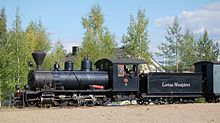 Lovisa-Wesijärvi Railway (LWR) 2-8-0 steam locomotive number 6 (built in 1909) in running order on Jokioinen Museum Railway, Finland.
Lovisa-Wesijärvi Railway (LWR) 2-8-0 steam locomotive number 6 (built in 1909) in running order on Jokioinen Museum Railway, Finland.
The vast majority of Finnish narrow gauge railways were owned and operated by private companies. There are only a few instances where narrow gauge railways were in direct connection with each other, and those interchanges did not last for long. The railways never formed a regional rail traffic network, but were only focused on maintaining connections between the national broad gauge railway network and the off-line industries. One of the longest common carriers was the Lovisa-Wesijärvi railway (1900–1960) that operated a 80 km (50 mi) line between Lahti and Loviisa. Other notable ones were the Hyvinkää–Karkkila railway that operated a 46 km (29 mi) line, and the Jokioinen railway that operated a 23 km (14.3 mi) line until 1974, being the last common carrier narrow gauge railway.
Other lines were notably shorter. The common gauges were 600 mm (1 ft 11 5⁄8 in) and 750 mm (2 ft 5 1⁄2 in), with a few railways built with 785 mm (2 ft 6 9⁄10 in) and 1,000 mm (3 ft 3 3⁄8 in) gauges.
Narrow gauge tourist and heritage lines of 600 mm (1 ft 11 5⁄8 in) and 750 mm (2 ft 5 1⁄2 in) gauge still operate.
France
The French National Railways used to run a considerable number of 1,000 mm (3 ft 3 3⁄8 in) lines, a few of which still operate mostly in tourist areas, such as the St Gervais-Vallorcine (Alps) and the "Train jaune" (yellow train) in the Pyrenees. The original French scheme was that every sous-prefecture should be rail connected. Extensive near 600 mm (1 ft 11 5⁄8 in) gauge lines were also built for the sugar-beet industry in the north often using ex-military equipment after the First World War. Decauville was a famous French manufacturer of industrial narrow gauge railway equipment and equipped one of the most extensive regional 600 mm (1 ft 11 5⁄8 in) narrow gauge railway, the Chemins de Fer du Calvados. Corsica has a narrow gauge network of two lines following the coast line, that are connected by one line crossing the island through highly mountaineous terrain. The petit train d'Artouste, a tourist line in the Pyrenees, uses 500 mm (19 3⁄4 in) gauge.
Germany
A number of narrow gauge lines survive, largely as a consequence of German reunification, in the former East Germany where some of them form part of the public transport system as active commercial carriers. Most extensive of those still employing steam traction is the Harz mountain group of metre gauge lines, the Harzer Schmalspurbahnen. Other notable lines are the Zittau-Oybin-Jonsdorf line in Saxony, the Mollibahn and the Rügensche Kleinbahn on the Isle of Rügen on the Baltic coast and the Radebeul-Radeburg line, Weisseritztalbahn in the suburbs of Dresden. Although most rely on the tourist trade, in some areas they provide significant employment as steam traction is particularly labour intensive.
In the Western part of Germany, Selfkantbahn (close to Heinsberg near Aachen) and Brohltalbahn (Linz/Rhine) are the best known ones, offering services in summer weekends.
Greece
Main article: rail transport in GreeceThe Peloponnese narrow gauge network length is about 914 km. Of this, metre gauge is used for 892 km. This is the network that connects major cities in the Peloponnese. The remaining 22 km form the Diakofton-Kalavryta Rack Railway, which uses 750 mm (2 ft 5 1⁄2 in) gauge. The Peloponnese network has suffered various setbacks, ranging from the abandonment of entire lines (such as the Pyrgos Katakolon Railway) to inefficient management on part of the public Greek railway operator, OSE, which resulted in poor quality of services and rolling stock. Currently major restoration works are underway, which have resulted in parts of the line having been closed. Additionally, the reactivation of certain lines that were closed down during the latter half of the 20th century is planned, mainly the Pyrgos-Katakolon line and in parts of western Greece (around Agrinion and Messologgi).
Another small railway which uses narrow gauge 600 mm (1 ft 11 5⁄8 in) is the Mt. Pelion railway, originally from Volos to Milies. Currently parts of the line are operational during the summer, mainly for excursions.
There was also a metre gauge network in Thessaly. This has now been replaced with single track standard gauge lines from Volos to Larissa and Palaiofarsalos to Kalampaka. However, the old narrow gauge tracks remain in place between Velestino and Palaiofarsalos via Aerino, so that occasional special excursion trains use them.
A metric line network existed in Attica, operated by Attica Railways and later by SPAP. The line ran from the center of Athens to Kifissia with a branch from Heraklion to Lavrion, serving the suburbs and towns of the region as well as Dionysos marble quarries and Lavrion mines. The line to Kifissia closed in 1938 and was reopened as standard gauge in the 1950s, operated by ISAP. The line to Lavrion closed in 1957 due to political pressures from the road transport lobby. Sections of the Lavrion line still survive and there are plans to reopen the southern part (Koropi-Lavrion) as an electrified standard gauge suburban line.
Development of open lignite mines for electricity production led to the construction of industrial railway networks in Ptolemais, Western Macedonia (900 mm/2 ft 11 1⁄2 in industrial gauge, electrified) and Aliveri, Evoia Island (1,000 mm/3 ft 3 3⁄8 in). These networks are no longer active, as the lignite mines they served are exhausted.
The 750 mm (2 ft 5 1⁄2 in) railway in Diakofto-Kalavryta and the 600 mm (1 ft 11 5⁄8 in) in Volos-Milies (the current operational line is Lechonia-Milies, since the Volos-Lechonia section was abandoned) are heritage railways. The metre gauge network of Peloponnese, however, is a busy passenger line, although there are no longer freight trains. A major project has started to construct new 1,435 mm (4 ft 8 1⁄2 in) lines in the busiest parts of Peloponnese and to rebuild the century-old tracks in the remainder. The branch lines from Asprohoma to Messini and from Pyrgos to Katakolo were re-opened for passenger services in September and April 2007 respectively and the Corinth to Argos, Nafplio and Tripoli line was reopened in August 2009.
- I. Zartaloudis, D. Karatolos, D. Koutelidis, G. Nathenas, S. Fasoulas, A. Filippoupolitis, A. (1997) (in Greek). Οι Ελληνικοί Σιδηρόδρομοι (Hellenic Railways). Μίλητος (Militos). ISBN 960-8460-07-7. It is the only extensive and authoritative source for the history of Greek railways.
- Simms, W.F. (1997). The railways of Greece. Wilfried F. Sims. ISBN 0-9528881-1-4. Contains brief history, simple line maps ans extensive list of rolling stock until 1997.
- Organ, J. (2006). Greece Narrow Gauge. Middleton Press. ISBN 1-904474-72-1.
Hungary
Main article: Rail transport in HungaryThe former Kingdom boasted a narrow gauge network thousands of kilometres in length, most of it using Bosnian gauge 760 mm (2 ft 5 7⁄8 in) or 600 mm (1 ft 11 5⁄8 in) gauge, constructed between 1870 and 1920. Landlords, mines, agricultural and forest estates established their own branch lines which, as they united into regional networks, increasingly played a role in regional passenger traffic. Following the Treaty of Trianon some railways were cut by the new border, many remained on the territory of Romania, Czechoslovakia and Yugoslavia. Due to a lack of intact roads, following World War II in many places narrow-gauge railway was the only reasonable way to get around. In 1968 the Communist government started to implement a policy to dismantle the narrow-gauge network in favour of road traffic. Freight haulage on the few remaining lines continued to decline until 1990 from when a patchwork of railways was gradually taken over by associations and forest managements for tourist purposes. State Railways operated narrow-gauge railways at Nyíregyháza and Kecskemét that played a role in regional transport until December 2009. Children aged 10 to 14 provide services at the Budapest Children's Railway.[5][6]
Ireland
Several 3 ft (914 mm) narrow gauge systems once existed in Ireland. In County Donegal an extensive network existed, with two companies operating from Derry – the Londonderry & Lough Swilly Railway (L&LSR) and the County Donegal Railways (CDRJC). Well known was the West Clare Railway – in County Clare, which saw diesel locomotion before closure. The Cavan & Leitrim Railway (C&LR) operated in what is now the border area of County Cavan and County Leitrim. Some smaller narrow gauge routes also had existed in County Antrim and also County Cork – notably the Cork Blackrock & Passage Railway - had been removed.
Apart from small heritage venues, the Irish narrow gauge today only survives in the bogs of the Midlands as part of Bord na Móna's extensive industrial network for transporting harvested peat to distribution centres or power plants.
Italy
Narrow gauge railways in Italy are (or were) mainly built with 950 mm (3 ft 1 3⁄8 in) gauge, with some 1,000 mm (3 ft 3 3⁄8 in) gauge lines and with a few other gauges.
In Istria, narrow gauge railway line called Parenzana was built from Trieste - Capodistria now Koper Slovenia - to Parenzo now Poreč Croatia (dismantled). The Trieste-Opicina is a 1,000 mm (3 ft 3 3⁄8 in) tramway with a funicular. In Naples is the Circumvesuviana which operates services around the Vesuvius.
In Sardinia, a network of narrow gauge lines (950 mm/3 ft 1 3⁄8 in) was built, to complement the standard-gauge main network which covered the main cities and ports. The lines were:
- Isili-Villamar-Villacidro (dismantled)
- Villamar-Ales (dismantled)
- Macomer-Bosa (dismantled between Bosa Marina and Bosa) (tourist service only)
- Macomer-Tirso-Nuoro
- Tirso-Ozieri (dismantled)
- Sassari-Alghero, Sassari-Sorso
- Sassari-Tempio Pausania-Luras-Palau (tourist service only)
- Luras-Monti (dismantled).
Of the lines which are still present, only
still carry regular passenger services, operated by Ferrovie della Sardegna (Railways of Sardinia). The others only operate a scenic tourist service known as Trenino verde (small green train)
In Sicily, the Ferrovia Circumetnea (950 mm/3 ft 1 3⁄8 in gauge) runs around the Mount Etna. Other 950 mm (3 ft 1 3⁄8 in) narrow gauge lines of Ferrovie dello Stato operated, but are now closed. The last of which was the Castelvetrano-Porto Empedocle, closed in 1985.
In Trentino only the 1,000 mm (3 ft 3 3⁄8 in) narrow gauge lines from Trento to Malè and Marilleva are still operating by Trentino Trasporti. Recently the line has been renovated and extended to Fucine.
In South Tyrol in Italy there are two 1,000 mm (3 ft 3 3⁄8 in) gauge lines: the Rittnerbahn, or Ferrovia del Renon, a very nice rural tramway and the Laas-Lasa freight private railway to marble cave, that use a funicular too. There are two tourist mines using 600 mm (1 ft 11 5⁄8 in) gauge trains.
Between Naples and Sorrento, around the base of Mt. Vesuvius, the Circumvesuviana railway operates frequent services on 950 mm (3 ft 1 3⁄8 in) tracks.
In the Puglia and Basilicata regions there are some 950 mm (3 ft 1 3⁄8 in) lines connecting Bari, Potenza, Matera and Avigliano. These are owned by Ferrovie Apulo Lucane.
In Calabria there are the Catanzaro Lido-Catanzaro-Cosenza 950 mm (3 ft 1 3⁄8 in) line, with a branch to Camigliatello Silano, and two lines from Gioia Tauro. All are owned by Ferrovie della Calabria.
The Genova-Casella is a 1,000 mm (3 ft 3 3⁄8 in) line.
Isle of Man
Both main railways in the Isle of Man are of 3 ft (914 mm) gauge. The Isle of Man Steam Railway to the southwest is operated largely as a tourist attraction but the Manx Electric Railway to the northeast is a commercially operated railway system though its operation is closer to that of a tramway than a railway. The Snaefell Mountain Railway, climbs the island's main peak and has a gauge of 3 ft 6 in (1,067 mm); it is the sole operating Fell Incline Railway System in the world.
Latvia
There are one public, one museum and some industrial peat railways.
A public 750 mm (2 ft 5 1⁄2 in) narrow gauge railway of around 30 km long joins the towns of Gulbene and Aluksne (two trains per day). More: http://www.banitis.lv.
There is a museum railway in Ventspils. The gauge is 600 mm (1 ft 11 5⁄8 in) and the length is a 2 km circle. The locomotives are former "Brigadelok" steam locomotives. From 1918 until the early 1960s they ran a regular service from Ventspils along the coast to Mazirbe and further down to Talsi and Stende.
The peat companies mainly use 750 mm (2 ft 5 1⁄2 in), but there also exist 700 mm (2 ft 3 9⁄16 in) and 600 mm (1 ft 11 5⁄8 in) gauge railways.
Lithuania
158.8 km of 750 mm (2 ft 5 1⁄2 in) narrow gauge lines remain, although only 68.4 km of them (serving five stations) are regularly used, employing 12 locomotives. They are included in the Registry of Immovable Cultural Heritage Sites of Lithuania.[7] There also still exist many peat factories, which have private narrow gauge railways for transportation peat from field to factory.
Norway
In Norway, a number of main lines were in the 19th century built with narrow gauge, 3 ft 6 in (1,067 mm), to save cost in a sparsely populated mountainous country. This included Norway's first own long-distance line, Rørosbanen, connecting Oslo and Trondheim, 1877. Some secondary railways also had this gauge. These railways have been rebuilt to standard gauge or closed down. Some private railways had 750 mm (2 ft 5 1⁄2 in) and one had 1,000 mm (3 ft 3 3⁄8 in). A few railways partly still are operated as museum railways, specifically Thamshavnbanen, Urskog-Hølandsbanen and Setesdalsbanen. The tramway in Trondheim, Gråkallbanen is also narrow gauge.
Poland
There are hundreds of kilometres of 600 mm (1 ft 11 5⁄8 in), 750 mm (2 ft 5 1⁄2 in), 785 mm (2 ft 6 9⁄10 in), and 1,000 mm (3 ft 3 3⁄8 in) narrow gauge lines in Poland. The metre gauge lines are mostly found in the northwest part of the country in Pomerania, while 785 mm (2 ft 6 9⁄10 in) lines are found only in the Upper Silesia region. 750 mm (2 ft 5 1⁄2 in) is the most commonly used narrow gauge; it is used, for example, in the Rogów Narrow Gauge Railway (Rogowska Kolej Wąskotorowa). Some narrow gauge lines in Poland still operate as common carriers (for example the lines operated by SKPL, the Association of Local Railway Haulage),[8] while others survive as tourist attractions. One of the finest of the latter is the 600 mm (1 ft 11 5⁄8 in) narrow gauge railway (Żnińska Kolej Powiatowa) running from Żnin via Wenecja (Polish Venice) and famous Biskupin to Gąsawa in the Pałuki region. Railway traditions of Pałuki date back to July 1894 when the first two lines were opened.
In the past, there have also been 760 mm (2 ft 5 7⁄8 in), 800 mm (2 ft 7 1⁄2 in) and 900 mm (2 ft 11 1⁄2 in) lines. A 900 mm (2 ft 11 1⁄2 in) recreational line 4.2 km long still operates in the Amusement-Recreation Park in Chorzów, Upper Silesia. A similar 600 mm (1 ft 11 5⁄8 in) line, Kolejka Parkowa Maltanka, operates in Poznań. Some of Poland's narrow gauge railways are maintained by volunteers; one organization dedicated to preserving narrow gauge railways is the FPKW, the Polish Narrow Gauge Railways Foundation.[9]
Portugal
Portugal had hundreds of km of 1,000 mm (3 ft 3 3⁄8 in) gauge railways, including: Linha do Porto à Póvoa e Famalicão - Closed. Some of the old trackbed is now used by the Oporto's Metropolitan railcars. Linha de Guimarães - Closed between Guimarães and Fafe, converted into a bike way. The rest is now broad gauge. Linha do Tâmega. Linha do Corgo. Linha do Tua. Linha do Sabor. Linha do Vouga (closed in Sernada do Vouga - Viseu, working in Aveiro - Sernada do Vouga - Albergaria-a-Velha - Oliveira de Azeméis - Espinho). Linha do Dão.
Four passenger services are known to still be in operation.
The Tamega Line runs between Livração and Amarante in the District of Oporto and runs near the River Tâmega.
The Corgo line runs from Regua, on the Douro River to Vila Real. The line previously ran to Chaves and the track is still in situ in 2008. There is a small Railway Museum at Chaves.
The Tua Line runs north from Tua to Bragança and previously ran to Mirandela. This line is the least used and may close soon but was still operating in spring 2008. The line was closed temporarily on 10 April 2008 after a landslide which cause the derailment of a light inspection vehicle near Santa Luzia station, and it's unknown when the line will reopen.
Finally a line still runs from Oporto to Lisbon main line at Espinho to Sernada do Vouga and back to the same main line at Aveiro, Linha do Vouga. This line has a museum at Macinhata do Vouga whilst the main workshops are at Sernada do Vouga. This line may also shut at any time.
Romania
Main article: Rail transport in RomaniaRomanian narrow-gauge tracks usually use a 760 mm (2 ft 5 7⁄8 in) gauge, though there were also some 700 mm (2 ft 3 9⁄16 in) gauge locomotives manufactured at Reşita.[10] Several old narrow-gauge railways in Romania are being renovated for tourist purposes: the one in the Vaser Valley (Maramureş County) is now well known, the line from Abrud to Campeni is sporadically operating and other renovation projects have made tentative steps and may commence regular operations in the near future, such as the Sibiu-Agnita railway,[11] which has been declared as a historical monument and is now starting to be restored by volunteers. More information can be found under "mocăniţă", the term by which such railways are often called in Romanian.
Russia
Main article: Rail transport in RussiaIn Russia, while older imperial Russian narrow gauge was 3 ft 6 in (1,067 mm), current narrow gauge is most often 750 mm (2 ft 5 1⁄2 in) or 1,000 mm (3 ft 3 3⁄8 in). 3 ft 6 in (1,067 mm) gauge is remained only in the southern part of Sakhalin Island (to be converted to 1,520 mm (4 ft 11 5⁄6 in)), where railways were built by the Japanese. A complete list of Russian and other ex-Soviet Narrow Gauge railways.
Serbia
Main article: Rail transport in SerbiaThe narrow gauge railway line in Mokra Gora on the northern slopes of mountain Zlatibor in Serbia climbs a 300 metre ascent using an unusual loop in the form of the figure 8 – the popular "Šargan Eight".
Slovakia
Bratislava municipal transport system uses 1,000 mm (3 ft 3 3⁄8 in) gauge for trams, while Košice transport system uses standard gauge 1,435 mm (4 ft 8 1⁄2 in). Railways, however use standard gauge 1,435 mm (4 ft 8 1⁄2 in) making Bratislava tram and railways networks incompatible with each other. There is a discussion regarding transforming Bratislava's tram gauge to standard gauge to allow trams to use the railways tracks to increase transportation capabilities of Bratislava's public transportation system. The most notable tourist lines in operation are the 760 mm (2 ft 5 7⁄8 in) gauge Čiernohronská železnica and Oravsko-kysucká lesná železnica - Vychylovka. Another notable narrow gauge tracks include: the Štrbské Pleso - Štrba rack railway and the Tatra Electric Railway (both 1,000 mm (3 ft 3 3⁄8 in) gauge) in the Tatra mountains and the 760 mm (2 ft 5 7⁄8 in) gauge railway from Trenčianska Teplá to Trenčianske Teplice.
Slovenia
Main article: Rail transport in SloveniaThe narrow-gauge railway line was built in the valley of Dravinja, connecting Poljčane - Slovenske Konjice - Zreče (dismantled 1962).
In formerly Italian Istria, a narrow gauge railway line called Parenzana, a.k.a. Trieste - Buje - Parenzo, connected Trieste (Italy) - Capodistria Koper, Isola d'Istria Izola (Slovenia) - Parenzo Poreč (Croatia) (dismantled).
Spain
In Spain there is an extensive system of 1,000 mm (3 ft 3 3⁄8 in) gauge railways, in the north of the country, operated by FEVE (Ferrocarriles Españoles de Vía Estrecha, Spanish narrow gauge railways) and EuskoTren (Eusko Trenbideak, Basque Railways). At the centre of this system is a metre gauge line which runs for 650 km (404 mi) along the entire length of Spain's north coast. FEVE and EuskoTren form the longest narrow gauge network in Europe. Also near Madrid, on the mountain range of Guadarrama runs a mountain train through a short but extremely sinuous track, operated by Renfe. Separate metre gauge railways are operated by the FGC (Ferrocarrils de la Generalitat de Catalunya, Catalan regional government railways) from Barcelona to Manresa and Igualada, the FGV (Ferrocarrils de la Generalitat Valenciana, Valencian regional government railways) around the city of Valencia, as well as along the Costa Blanca from Alicante to Denia, and the SFM (Serveis Ferroviaris de Mallorca) on the island of Majorca. Also on the island of Majorca, the FS (Ferrocarril de Sóller) operates a 3 ft (914 mm) gauge electrified railway and connecting tramway. Also the Euskotran in Bilbao, which is not a "light rail", is unusual in new tramway and light rail systems opened in the last twenty-five years in having adopted metre gauge. EuskoTran is part of EuskoTren, the Basque regional government rail company. This company also owns several bus lines. Metro Bilbao started in 1995 on EuskoTren track and has a metre gauge.
Sweden
Sweden once had some fairly extensive narrow gauge networks, but most narrow gauge railways are now closed. Some were converted to standard gauge (the latest one the line between Berga and Kalmar in the 1970s) and some remain as heritage railways. The most common narrow gauge, 891 mm (2 ft 11 1⁄10 in) (3 Swedish feet), existed only in Sweden. A smaller 3 ft 6 in (1,067 mm) gauge network existed, and 600 mm (1 ft 11 5⁄8 in) gauge was used mostly by smaller, industrial railways.
The only commercial narrow gauge railway left is the Roslagsbanan suburban railway in north-eastern Stockholm (891 mm/2 ft 11 1⁄10 in gauge). A branch line, the Långängsbanan, was built and run for some years as an isolated standard gauge tramway in anticipation of a planned conversion of the main line to raise its capacity, but those plans came to naught and the branch was rebuilt to narrow gauge; it is now closed.
The longest other remaining narrow gauge railway is the 891 mm (2 ft 11 1⁄10 in) line between Åseda, Hultsfred and Västervik. 70 km between Hultsfred and Västervik as well as the shorter sections between Virserum-Hjortöström and Åseda-Hultanäs are served by tourist trains in the summer, including 4 km of dual gauge track.
Between Bor and Os, Värnamo in Småland, there is a 600 mm (1 ft 11 5⁄8 in) gauge that today is in use as a tourist railway with steam trains.
Sweden also had the unique 1,093 mm (3 ft 7 in) gauge Köping-Uttersberg-Riddarhyttan Railway. Still other but lesser used gauges in the country were 802 mm (2 ft 7 3⁄5 in), 1,188 mm (3 ft 10 4⁄5 in) and 1,217 mm (3 ft 11 9⁄10 in).
Switzerland
 A train at Bad Bubendorf station on the 750 mm (2 ft 5 1⁄2 in) gauge Waldenburgerbahn between Liestal and Waldenburg in Switzerland.[12]
A train at Bad Bubendorf station on the 750 mm (2 ft 5 1⁄2 in) gauge Waldenburgerbahn between Liestal and Waldenburg in Switzerland.[12]
Switzerland boasts extensive networks of 1,000 mm (3 ft 3 3⁄8 in) metre gauge railways, many of which interchange traffic (most prominent is the Rhaetian Railway). They are concentrated in the more heavily mountainous areas. The Jungfraubahn terminates at the highest station in Europe. Dual gauge (combined metre- and standard gauge trackway) also exists in many areas. Also, nearly all street tramways in Switzerland were and still are also metre gauge.
Ukraine
There are three operating passenger 750 mm (2 ft 5 1⁄2 in) gauge lines in Ukraine: Vynohradiv–Khmilnyk (in Zakarpattia Oblast), Rudnytsia–Holovanivsk (Haivoron line in Vinnytsia Oblast and Kirovohrad Oblast, 130 km or 81 mi), Antonivka–Zarichne (in Rivne Oblast).
Children's railways of 750 mm (2 ft 5 1⁄2 in) gauge operate in Dnipropetrovsk, Donetsk, Kharkiv, Kiev, Lutsk, Lviv, Rivne and Zaporizhia.
United Kingdom
The United Kingdom once had a large number of narrow gauge railways which were mostly isolated from each other. The first locomotive-hauled railway in the world was the narrow gauge Penydarren Tramway in south Wales. Most of the lines were originally built to haul minerals or agricultural products over short distances, though many also carried passengers. The longest passenger line was the combined Welsh Highland and Ffestiniog railways at 36 miles / 58 kilometres. The Welsh Highland was completely re-opened in 2011 giving a total length (together with the Ffestiniog) of about 40 miles (64 km).
Only a few of these lines survive as commercial common carriers. The great majority of the remaining narrow gauge lines operate purely as tourist attractions, and a number of new narrow gauge tourist lines have been built in recent years. The sole passenger-carrying exception is the Glasgow Subway, an underground metro line that operates on a 4 ft (1,219 mm) gauge. The Talyllyn Railway holds the distinction of being the first railway in the world of any gauge to be run entirely by volunteers. In addition a few private industrial narrow gauge railways remain, mainly serving the coal and peat extraction industries.
Amongst the most well-known narrow gauge lines in Britain are the Ffestiniog - one of the earliest railway organisations in the world - the Corris, the Vale of Rheidol, and the Welshpool & Llanfair in Wales, and the Lynton & Barnstaple and the Romney, Hythe and Dymchurch, in England. Unique amongst British railways is the rack-and-pinion Snowdon Mountain Railway which climbs to just below the summit of Wales' highest peak.
North America
Canada
Although many railways of central and eastern Canada were initially built to a 5 ft 6 in (1,676 mm) (broad gauge), there were several railways, especially on Canada's Atlantic coast, which were built as individual narrow gauge lines.
The first public passenger carrying narrow gauge railways in North America were in Ontario, the Toronto, Grey and Bruce Railway and the Toronto and Nipissing Railway, opening in the summer of 1871. These 3 ft 6 in (1,067 mm) Ontario lines were over 300 miles (483 km) in length, and both were built with the objective of connecting with a future Pacific railway. The New Brunswick Railway and the Lake Champlain and St. Lawrence Junction Railway of Quebec were built to the same gauge. All were acquired and converted to standard gauge in 1881 and eventually became part of the Canadian Pacific Railway.
Construction of the 3 ft 6 in (1,067 mm) Prince Edward Island Railway began in 1871 and was completed by the Canadian government in 1874 as a condition for Prince Edward Island joining the Canadian Confederation. Construction on the 3 ft 6 in (1,067 mm) Newfoundland Railway took place between 1881 and 1898. It became part of the Canadian National Railways (CNR) when Newfoundland became part of Canada in 1949.
The 3 ft (914 mm) White Pass and Yukon Route, which was completed in 1900 at the end of the Klondike gold rush, is Canada's last remaining narrow gauge carrier. It no longer carries freight, but is the busiest tourist railroad in North America. Its tracks connect to no other railroad but do connect to the cruise ship docks at Skagway, Alaska, which provide it with most of its passengers.
Mexico
Various 3 ft (914 mm) narrow gauge lines operated around Mexico City. A famous one operated in Morelos State. There were dozens of private narrow gauge lines built to service the mining district, and some 2 ft (610 mm) common carriers including the Córdoba and Huatusco Railroad, Cazadero and San Pablo Railroad, Hornos Railroad, and Tacubaya Railroad.
The Yucatán Peninsula region of Mexico has a network of narrow gauge lines, established before the region was linked by rail to the rest of Mexico in the 1950s. Only the main line connecting Mérida to central Mexico has been widened to standard gauge.
United States
Many narrow gauge railways were built in the United States. The most extensive and well known systems were the 3 ft (914 mm) gauge lines through the Rocky Mountain states of Colorado and New Mexico. For a while the majority of the railway mileage in these states was narrow gauge.
In 1882, thirty-two narrow-gauge logging railroads were constructed in Michigan, and by 1889 there were eighty-nine such logging railroads in operation, totaling almost 450 miles (720 km) of track.[13]
In Maine, a network of 2 ft (610 mm) gauge lines served the rural economy between the 1870s and 1940s. Across the US, industrial narrow gauge railways were used, perhaps the best known being the 3 ft (914 mm) gauge logging lines of the western states of Oregon and California. In Pennsylvania, the 3 ft (914 mm) gauge coal-hauling East Broad Top Railroad is the oldest surviving 3-foot (0.91 m) gauge in the United States hauling excursion trains during the summer months.
Today a few lines survive as heritage railways and tourist attractions. USG Corporation operates an industrial 3 ft (914 mm) gauge line at Plaster City, California and narrow gauge railways are still used for some tunneling and mining work. Tweetsie Railroad in western North Carolina still operates today as a family tourist attraction.
Disneyland park in Anaheim, CA also operates a small narrow gauge railway inside its park to transport and entertain guests.
Central America
Costa Rica
Costa Rican railways are 1067mm {Cape} gauge. Due to its mountainous terrain, the first railway was laid using Cape Gauge in 1871. This set the standard for other railways to use the same gauge. Currently all 950 km of rail are 1067mm. They are state owned and operated by INCOFER.
See also Railways in Costa Rica
El Salvador
El Salvador ran 3 ft (914 mm) gauge steam trains into the 1970s. How much of this survived a civil war, earthquake and hurricane is unknown. However, the country began to rebuild and fix existing tracks in anticipation for new train service. FENADESAL currently uses the tracks to connect the capital city of San Salvador to it's suburbs. There are now more plans to start a metro rail on the current tracks, making it the most effective narrow gauge train tracks in Central America.
See also
Guatemala
- 3 ft (914 mm) gauge, Ferrovías Guatemala[14]
Haiti
Haiti has had two different gauges on its railways. 130 km of rural line between Port-au-Prince, Saint-Marc, and Verrettes (1905–about 1960s) used 3 ft (914 mm) gauge. Tramlines in Port-au-Prince (1878–1888 and 1896–1932), which was the first known track in Haiti, and a total of 80 km of rural line west to Léogâne and east to Manneville (1896–1950s(?)) used 3 ft (914 mm) gauge. Totalling over 100 km of track, the plantation railways in the north and north-east most likely used 2 ft 6 in (762 mm). There were at least four separate isolated lines. The story of the demise of one Haitian railroad is that it was sold and physically picked up, and shipped to Asia during the Papa Doc period (approx. 1957–1971). Other gauges may have been used on the plantation tracks in the north and north-east of Haiti. The CIA fact book suggests that in the 1990s there were only 40 km of abandoned track left(?).
Panama
Mule Locos haul ships through the locks in the Panama Canal (Gauge???)
See also
- Transport in Panama
South America
Metre and 914 mm (3 ft) gauge lines are found in South America. Some of the 1,000 mm (3 ft 3 3⁄8 in)-gauge lines cross international borders, though not as efficiently as they might.
Argentina, Bolivia, Brazil and Chile have 1,000 mm (3 ft 3 3⁄8 in) gauge lines. Colombia and Peru have 914 mm (3 ft) gauge lines.
Argentina
1,000 mm (3 ft 3 3⁄8 in) railways are found in the northern half of the country. The Old Patagonian Express (La Trochita) is a 402 km-long 750 mm (2 ft 5 1⁄2 in) narrow gauge railway in the Andean foothills of Patagonia, now running as two portions of its original length, and only as a tourist attraction. However, all the track is preserved. The Southern Fuegian Railway (End of the World Train) on a 500 mm (19 3⁄4 in) track is considered the southernmost operating railway in the world, also solely as a tourist operation. The Rainforest Ecological Train is a 600 mm (1 ft 11 5⁄8 in) environmentally-friendly train that runs through the forest inside Iguazú National Park in the north of the province of Misiones of Argentina and there is also a coal railway, Red de Ferrocarril Industrial de Rio Turbio, that however is no longer in operation. It previously operated between Rio Turbio and Rio Gallegos on 750 mm (2 ft 5 1⁄2 in) track gauge.
Bolivia
All railways in Bolivia are 1,000 mm (3 ft 3 3⁄8 in) gauge.
Brazil
In Brazil, almost all the lines are 1,000 mm (3 ft 3 3⁄8 in) gauge, with the exception of a few lines in the states of São Paulo, Minas Gerais, Rio de Janeiro and Mato Grosso. Vale (ex-CVRD) also has a line with 1,600 mm (5 ft 3 in) gauge lines once operated in Minas Gerais, centered around the city of São João del-Rey. This network at one time had over 770 km of railway in operation, but only about 13 km remain in operation as a steam powered tourist railway. Other small narrow gauge lines include the Rio de Janeiro streetcar (Bonde de Santa Teresa), with approximately 13 km of 1,100 mm (3 ft 7 7⁄16 in) gauge, and a very short industrial railway near Bertioga built to 800 mm (2 ft 7 1⁄2 in) gauge. A number of industrial (a 2 ft (610 mm) gauge Portland Cement line near São Paulo, for example) and agricultural (rubber plantations, sugar plantations, logging) railways also existed in Brazil in a number of narrow gauges, but few of those survive today.
Chile
Main article: rail transport in ChileMetre gauge railways are found in the northern half of the country but are no longer in operation. The Ferrocarril de Antofagasta a Bolivia was originally built to 2 ft 6 in (762 mm) gauge, as were a number of mining and nitrate railways. The Transandean railway was metre gauge but is no longer in operation between Chile and Argentina. However, there is a short section used for industrial (copper) operations in the area between the station at Los Andes and the Río Blanco station.
Colombia
Most of the railways in Colombia are 914 mm (3 ft) gauge.
Ecuador
Main article: rail transport in EcuadorThe railways in Ecuador are 1,067 mm (3 ft 6 in) cape gauge. This is a famous route, the one that zig zags past the chilling canyon of the Devil's Nose. Floods, landslides and government neglect have put this operation in doubt, but they are working to restore the railway. The recently elected president Rafael Correa declared the state of emergency of the national railway. He has secured funding for a master plan to restore it to its previous glory. In the first phase of this plan, the Ecuadorian government will invest over US $283 million to completely repair the country's existing railway system and infrastructure, such as bridges, walls and stations. The government will also purchase new locomotives. A second phase seek the building of new railway lines to connect the country with Brazil and Venezuela. Currently two Baldwin locomotives are ready to work, depending on track and traffic. There are also a number of diesel railbuses and some Alsthom diesel locomotives available.
The railway from Guayaquil to Quito featured in the 1983 BBC television series Great Little Railways.
Peru
Main article: Rail transport in PeruThe Cuzco-Quillibama line in Peru is 914 mm (3 ft) gauge. The other 914 mm (3 ft) narrow gauge line (Huancayo-Huancavelica) will be converted to standard gauge.
Uruguay
Main article: rail transport in UruguayThere were four big narrow gauge lines in Uruguay: Puerto del Sauce (now Juan Lacaze)-Terminal: 914 mm (3 ft) , (1901–1959), Piriapolis-Pan de Azucar: 750 mm (2 ft 5 1⁄2 in) (1903–1958), km 393-Arrozal 33: 600 mm (1 ft 11 5⁄8 in) and km 110-Cantera Burgueño: 600 mm (1 ft 11 5⁄8 in). All were dismantled. There were also several quarry lines of 600 mm (1 ft 11 5⁄8 in) gauge, among them the famous INDARE sand line. Around 300 m of that sand line is preserved and also a lot of steam locomotives. One of those is in working order. Also, a new narrow gauge line, of around 1 km, with two diesel locomotives from the former km 110-Cantera Burgueño line, was constructed in a park on the town of Santiago Vazquez, in the West of Montevideo.
Asia
Bangladesh, India, Pakistan and Sri Lanka inherited a diversity of rail gauges, some of which was 1,000 mm (3 ft 3 3⁄8 in). Indian Railways has adopted Project unigauge, which seeks to systematically convert most of its narrower gauge railways to 5 ft 6 in (1,676 mm).
Southeast Asia
The railways of Southeast Asia, including Vietnam, Cambodia, Laos, Thailand, Myanmar and Malaysia are predominantly 1,000 mm (3 ft 3 3⁄8 in) gauge. The proposed ASEAN Railway would be a standard gauge or dual gauge, using both metre and standard gauge regional railway networks, linking Singapore at the southern tip of the Malay Peninsula, through the Association of Southeast Asian Nations region Malaysia, Thailand, Laos and Vietnam to the standard gauge railway network of the People's Republic of China. Indonesia's railways are predominantly 1,067 mm (3 ft 6 in).
China
Some of the railway network of the People's Republic of China is 1,000 mm (3 ft 3 3⁄8 in) gauge.
Many narrow gauge railways existed in China. Metre gauge railways were popular in China in several regions before 1949. The 1,000 mm (3 ft 3 3⁄8 in) gauge Kunming-Hekou Railway (previously known as Sino-Vietnamese Railway) was built by French colonists between Vietnam and China. In Manchuria, lumber industries built narrow gauge railways into the forests, mostly of 2 ft 6 in (762 mm) gauge.
Hong Kong
In Hong Kong the Kowloon-Canton Railway was partially laid to 2 ft (610 mm) and 3 ft (914 mm) gauge during its construction in 1910 but was very soon converted to standard gauge. The Sha Tau Kok Railway was 2 ft (610 mm) gauge for much of its existence. The famous Hong Kong Tramways are 3 ft 6 in (1,067 mm) gauge, and the territory's metro, the MTR, runs on 1432 mm gauge except for the standard gauge KCR network it operates under a lease.
India
India has a substantial network of narrow gauge railways. The majority of these are 1,000 mm (3 ft 3 3⁄8 in) gauge or Metre gauge, totalling approximately 10,000 km of track. There are some 2 ft 6 in (762 mm) gauge railways, and a few that use 2 ft (610 mm) gauge; these are known as "narrow gauge" (as opposed to "metre gauge") lines in India.
As of 31 March 2008, of the 63,273 km railway lines in India, 9,442 km were metre gauge lines, and 2,749 km narrow gauge lines; the rest 51,082 km were broad gauge lines.[15]
In 1999 the 2 ft (610 mm) gauge Darjeeling Himalayan Railway was officially designated as a UNESCO World Heritage Site. It runs from Siliguri to Darjeeling in the state of West Bengal.
Indonesia
Indonesia had large numbers of narrow gauge railways supporting industry, mainly sugar cane plantations in Java. In recent years[update], sugar cane production in Java has been declining and the railways are now largely closed or used for tourism.
Most of the current active railways in Indonesia use the Cape gauge 1,067 mm (3 ft 6 in).
Japan
Except for the high-speed Shinkansen lines and JR East Ou Main Line and Tazawako Line, all of Japan Railways Group's network is narrow gauge, built at 1,067 mm (3 ft 6 in). Some companies, such as Kintetsu, Keisei Electric Railway, Keihin Electric Express Railway, Hankyu Railway, Toei Asakusa Line, Tokyo Metro's Ginza Line and Marunouchi line, use standard gauge.
Tokyo's Keio Electric Railway network and the Toei Shinjuku metro line, which operate through services, use an exceptional 1,372 mm (4 ft 6 in) gauge. This gauge is also used on the Tokyo and Hakodate tramways.
There are some dual gauge lines which allow Shinkansen trains to travel on narrow gauge branches. Japan adopted 762 mm (2 ft 6 in) as a standard narrow gauge for minor, forestry and industrial lines. However, most of these narrow gauge lines were abandoned and currently only four lines remain in operation.
Malaysia
Malaysia's oldest railway systems are solely 1,000 mm (3 ft 3 3⁄8 in) gauge, a standard that has been adopted since the British colonial government laid down the first railway lines in 1885.
Keretapi Tanah Melayu, the main railway operator in Peninsular Malaysia, uses metre gauge for the main west and east coast intercity lines, as well as railway lines spanning Singapore, from the Johor-Singapore Causeway to the Tanjong Pagar railway station. Existing metre gauge lines are also used for KTM Komuter, the country's commuter rail service, which links Kuala Lumpur with neighbouring suburbs. However, standard gauge is used by the newer light rail operators in Kuala Lumpur city (Putra LRT, Star LRT) as well as the privately operated Express Rail Link to the airport.
In Sabah, the North Borneo Railway ("Keretapi Negeri Sabah") runs a metre gauge line from Kota Kinabalu up to Tenom in the Crocker Ranges, via Beaufort. Steam trains are also used in this route.
Philippines
Except for the Light Rail Transit (LRT) and Metro Rail Transit (MRT) systems in Metro Manila, which have both been constructed to the international standard gauge, the Philippine National Railways ("PNR") uses the "Cape Gauge" of 3 ft 6 in (1,067 mm). The PNR currently operates only one line: from Manila to the southern Luzon city of Legaspi. Until the 1980s a more extensive network existed going as far north as San Fernando in La Union province. There are plans to restore the La Union line and to build new lines connecting Manila to Batangas and the international airport.
There are also a number of industrial narrow gauge steam railways operating in the sugar cane industry. These are concentrated on the islands of Negros and Panay. The Visayas region is the main center for the sugar cane lines; some of the mills, such as La Carlotta Milling in Negros, run charter trains for tourists. Abandoned lines exists on the islands of Cebu, abandoned in the 1950s or 1960s, Mindanao, and Panay, closed in the 1990s. There are plans to restore the Panay Rail line which connects Roxas City with Iloilo.
Taiwan
Taiwan started to build up railway in the Qing dynasty using 3 ft 6 in (1,067 mm) gauge. The Japanese colonial government, which ruled from 1895 to 1945, continued using 3 ft 6 in (1,067 mm). The system is now under Taiwan Railway Administration. The new Taipei Metro and Kaohsiung MRT use standard gauge. The Taiwan High Speed Rail (THSR), which started operation in January 2007, also uses standard gauge. An isolated 2 ft 6 in (762 mm) gauge line on the east coast was regauged to 3 ft 6 in (1,067 mm) when the line was interconnected.
A 2 ft 6 in (762 mm) narrow gauge Alishan Forest Railway stretches 72 km and connects the city of Chiayi to the mountain resort of Alishan. The line serves mainly as a tourist attraction and offers breathtaking mountain views.
On September 7, 2006, Taiwanese government declared a plan to update to a standard gauge system.[16] Though, it's not the first time that this plan was proposed. In fact, some of the facilities have allowed for standard gauge conversion such as the underground tunnels constructed since the late 1980s. Many experts criticize the proposal as prohibitively expensive especially given that most lines would likely experience modest, if any, benefits of upgrading.
Thailand
While the Northern Line was originally build as 1,435 mm (4 ft 8 1⁄2 in) standard gauge, the line was regauged after 1919 and the State Railway of Thailand now operates entirely on 1,000 mm (3 ft 3 3⁄8 in) gauge, including international through services to Malaysia ans Lao. However, standard gauge is used by the Bangkok Skytrain and the Bangkok Metro and the new Bangkok airport link due to be open in August 2009. In 2010, new high speed lines are to be standard gauge again.
Sri Lanka
Sri Lanka's railway network consist of 59km of narrow gauge owned by Sri Lanka Railways currently converted to broad gauge. This line runs from Colombo Fort to Awissawella and it is known as Kalani Valley Railway (කැලණි නිම්න දුම් රිය මාර්ගය) because it runs on the sides of Kalani River. Narrow gauge locomotives are categorized as Class N & P in SL coaster.
Africa
Narrow gauge railways are common in Africa, where great distances, challenging terrain and low funding have made the narrow gauges attractive. Many nations, particularly in southern Africa, including the extensive South African Railway network (Spoornet), use a 3 ft 6 in (1,067 mm) gauge. Metre gauge is also common, as in the case of the Uganda Railway. There used to be extensive 2 ft (610 mm) and 600 mm (1 ft 11 5⁄8 in) gauge networks in countries such as Morocco, Congo, Angola, Namibia and South Africa, but these have mostly been dismantled or converted. Some also survive in Egypt: in the countryside around Luxor, narrow gauge railways are used for the transportation of sugar cane.
Because Africa is divided into many countries, railways built by different governments tend not to link up with each other, each country's lines connecting its outlands with its own port. Incompatible gauges are therefore not obvious. For example, a link from Nigeria to Cameroon would join 3 ft 6 in (1,067 mm) to 1,000 mm (3 ft 3 3⁄8 in).
The railways of South Africa and many other African countries, including Angola, Botswana, Congo, Ghana, Mozambique, Namibia, Nigeria, Sudan, Zambia and Zimbabwe, use 1,067 mm (3 ft 6 in) gauge, sometimes referred to as Cape gauge. Kenya, Uganda and others use 1,000 mm (3 ft 3 3⁄8 in) gauge lines. In Tanzania former East African Railways lines are metre gauge while the TAZARA line is 3 ft 6 in (1,067 mm)
During the period of British colonisation of Africa, Cecil Rhodes advocated the construction of a Cape to Cairo railway, linking all British possessions along the eastern side of Africa between South Africa and Egypt. While most countries through which such a line would run have cape gauge lines, Tanzania and Kenya have metre gauge lines, although the TAZARA line in Tanzania is cape gauge.
Eritrea
Further north, the Eritrean Railway is in the midst of resurrecting its 950 mm (3 ft 1 3⁄8 in) narrow gauge railway, a relic of its former Italian colonial days that was abandoned and heavily damaged during Eritrea's war of independence. Neighbouring railways (should they ever connect) are 3 ft 6 in (1,067 mm) in Sudan and 1,000 mm (3 ft 3 3⁄8 in) in Ethiopia.
Cameroon
During the First World War when Cameroon was a German possession, a network of 2 ft (610 mm) gauge Feldbahn railways were built. These eventually extended to around 150 km of track serving rubber and palm oil plantations.[17]
The 1,000 mm (3 ft 3 3⁄8 in) gauge is now in use.
Morocco
Morocco had from 1912 - 1935 one of the largest 600 mm (1 ft 11 5⁄8 in) gauge network in Africa with total length of more than 1700 kilometres. After the treaty of Algeciras where the representatives of Great Powers agreed not to build any standard gauge railway in Morocco until the standard gauge Tangier - Fez Railway being completed, the French had begun to built military 600 mm (1 ft 11 5⁄8 in) gauge lines in their part of Morocco French Morocco.
South Africa
Originally standard gauge, the railways of the then Cape Colony changed to narrow gauge 3 ft 6 in (1,067 mm), sometimes known as Cape gauge, for cost-cutting reasons. However, with the development of a strong economy, with heavy export coal and iron ore traffic, and electrification of most main lines, South Africa, like Queensland, operates several narrow gauge trains that outdo most standard and broad gauge trains across the world. In fact, in 1989 the Sishen-Saldanha line set a world record by carrying the biggest train in history, 7.2 km long containing 660 wagons pulled by 15 locomotives and weighing 71,232 tonnes (70,107 long tons; 78,520 short tons), though most trains on this line routinely run with lower tonnage.[18] However, the proposed Gautrain railway between Johannesburg and Pretoria will operate on standard gauge, and will thus not be capable of using any of the country's existing rail network.
The Avontuur Railway operates between Port Elizabeth and Avontuur in South Africa. It is the longest 610 mm (2 ft) gauge route in the world[citation needed] at a length of 285 km. It is operated by the South African railway company Spoornet. The line is commonly known as the Apple Express.[19]
See also: Two foot gauge railways in South Africa
Tunisia
In Tunisia, the railway network in the central and southern part of the country is a metre gauge network, including the main lines Tunis-Sfax (Ligne de la Côte) and Tunis-Kasserine, and also the local Ligne du Cap Bon from Bir Bou Rekba to Nabeul.
Oceania
Australia
Main article: Australian narrow gauge railwaysQueensland, Tasmania, Western Australia and parts of South Australia adopted 1,067 mm (3 ft 6 in) gauge to cover greater distances at lower costs. Most industrial railways are built to 610 mm (2 ft) gauge. Three different rail gauges are currently in wide use in Australia, and there is little prospect of full standardisation.
Before 1901, each of the six British colonies was responsible for rail transport infrastructure. Queensland, Western Australia, and Tasmania constructed for narrow gauge railways. The other colonies built either standard gauge or broad gauge railways, maintaining only limited narrow gauge rail lines, except for South Australia, which built both narrow and broad gauge. As a result of this legacy, Australian railways are a mix of all three gauges.
In 1865, the Queensland Railways was the first mainline narrow gauge railway in the world.[20] Its tracks would eventually extend to around 9000 km. Queensland Rail operates the QR Tilt Train, with a maximum speed of 165 km/h. This train currently holds the Australian Railway Speed Record of 210.7 km/h. Queensland also has extensive sugar cane tramways of 2 ft (610 mm) gauge.
Following the success of the narrow gauge in Queensland, several narrow gauge lines were built in South East Australia. From the 1920s onwards several of these were converted to broad gauge. The first of these was the Port Wakefield Railway of 1867 where it was claimed that the cost of a railway varied with the cube of the gauge.[21]
Inspired by the success of the narrow gauge in Queensland, Western Australia adopted the same gauge. Until closure in 1958 Perth had the only narrow gauge tramway network of any considerable extent in mainland Australia.
The Northern Territory adopted narrow gauge when it was still part of South Australia, and a North-South transcontinental line was planned from Adelaide to Darwin in the 1870s. In the event this line was never completed, and due to flood damage and lack of traffic, the narrow gauge line was closed.
Tasmania converted to an all 1,067 mm (3 ft 6 in) gauge system in 1886, but introduced narrower-still 610 mm (2 ft) to reduce costs even more.
Four common carrier lines in Victoria were built to the 2 ft 6 in (762 mm) narrow gauge standard, to serve local farming and forestry communities. Sections of two lines (Belgrave to Gembrook and Thomson to Walhalla) have been restored as tourist railways.
New Zealand
New Zealand adopted narrow gauge 1,067 mm (3 ft 6 in) (cape gauge) due to the need to cross mountainous terrain in the country's interior. This terrain has necessitated a number of complicated engineering feats, notably the Raurimu Spiral. There are 1787 bridges and 150 tunnels in less than 4,000 km of track. Around 500 km of this track is electrified, on the North Island Main Trunk, between Palmerston North and Hamilton.
Much like Australia, there was initially no uniformity in track gauges in New Zealand. This was because the construction of railways was undertaken by the various provinces of New Zealand rather than the central government. The Canterbury Provincial Railways opened New Zealand's first railway in 1863 and used a broad gauge of 1,600 mm (5 ft 3 in) , while Southland built the Bluff and Kingston Branches to 1,435 mm (4 ft 8 1⁄2 in), and short segments of 1,435 mm (4 ft 8 1⁄2 in) railway were also constructed in the Auckland and Northland Regions. Eventually, under the public works schemes of Premier Julius Vogel, the railways of New Zealand were made to adhere to a 1,067 mm (3 ft 6 in) gauge. The first 1,067 mm (3 ft 6 in) gauge railway in New Zealand was the Dunedin and Port Chalmers Railway, which opened on 1 January 1873. Today, the network connects most major New Zealand cities, and is around 4,000 km in length.
See also
- Broad gauge
- Feldbahn
- Forest railway
- Heeresfeldbahn
- Light railway
- List of rail gauges
- Metre gauge
- Military railways
References
- ^ Whitehouse, Patrick and Snell, John B. (1984). Narrow Gauge Railways of the British Isles. ISBN 0-7153-0196-9.
- ^ QR.com.au
- ^ Shaw, Frederic J. (1958). Little Railways of the World. Howell-North.
- ^ Kellahn, Kristie (February 24, 2009). "Travelling Europe's stylish rail network". Sydney Morning Herald. http://www.smh.com.au/news/executive-style/travel/travelling-europes-stylish-rail-network/2009/02/24/1235237608815.html. Retrieved 2009-02-25.
- ^ Children's Railway
- ^ Zsuzsi Scenic Railway Debrecen
- ^ Siaurukas
- ^ Kalisz
- ^ Polish Narrow Gauge Railways Foundation
- ^ "List of Narrow Gauge Steam Locomotives in Romania". 2001. http://www.enzia.com/Pages/Railpg8.html. Retrieved 2007-11-20.
- ^ Sibiu-Agnita railway
- ^ Qaldenburgerbahn
- ^ Maybee, Rolland (1976). Michigan White Pine Era. Lansing, Michigan: Michigan Historical Com.. pp. 41. http://www3.delta.edu/michiganremembers/stories/Impact%20of%20Lumbering-Konwinski.htm.
- ^ Ferrovías Guatemala
- ^ compiled and edited by Research, Reference and Training Division. (2010). India Yearbook 2010. Publications Division, Ministry of Information & Broadcasting, Govt. of India. p. 961. ISBN 81 230 1557 7.
- ^ Taiwan National News
- ^ Rowe, D. Trevor (1990). Two feet between the tracks. Plateway Press. ISBN 1-871980-03-8.
- ^ UCW (2006). "Quality Manual" (PDF). UCW Partnership. Archived from the original on 2006-10-03. http://web.archive.org/web/20061003132556/http://www.ucw.co.za/QualityManual/UCWQualityManualSep06.pdf. Retrieved 2006-10-31.
- ^ Apple Express
- ^ Lee, Robert (2003). "Potential railway world heritage sites in Asia and the Pacific". Institute of Railway Studies, University of York. http://www.york.ac.uk/inst/irs/irshome/papers/robert2.htm.
- ^ "RAILWAY GAUGES.". South Australian Register (Adelaide, SA : 1839 - 1900) (Adelaide, SA): p. 2. 9 January 1867. http://nla.gov.au/nla.news-article39176098. Retrieved 14 August 2011.
- P.J.G. Ransom. Narrow Gauge Steam - Its origins and worldwide development, Oxford Publishing Co., 1996, ISBN 0-86093-533-7
- P. Whitehouse, J. Snell. Narrow Gauge Railways of the British Isles, David & Charles, 1994, ISBN C-7153-0196-9
- Railroads of Colorado: Your Guide to Colorado's Historic Trains and Railway Sites, Claude Wiatrowski, Voyageur Press, 2002, hardcover, 160 pages, ISBN 0-89658-591-3
- Keith Chester. "East European Narrow Gauge" 1995
- "Narrow Gauge Through the Bush - Ontario's Toronto Grey and Bruce and Toronto and Nipissing Railways"; Rod Clarke; pub. Beaumont and Clarke, with the Credit Valley Railway Company, Streetsville, Ontario, 2007. ISBN 978-0-9784406-0-2
- "The Narrow Gauge For Us - The Story of the Toronto and Nipissing Railway"; Charles Cooper; pub. The Boston Mills Press; Erin, Ontario, 1982.
- "Narrow Gauge Railways of Canada"; Omer Lavallee; pub. Railfair, Montreal, 1972.
- "Narrow Gauge Railways of Canada"; Omer Lavallee, expanded and revised by Ronald S Ritchie; pub. Fitzhenry and Whiteside, Markham, Ontario, 2005.
- "The Toronto Grey and Bruce Railway 1863-1884; Thomas F McIlwraith; pub. Upper Canada Railway Society, Toronto, 1963.
- "Steam Trains to the Bruce"; Ralph Beaumont; pub. The Boston Mills Press; Cheltenham, Ontario, 1977
- "Running Late on the Bruce"; Ralph Beaumont & James Filby; pub The Boston Mills Press, Cheltenham, Ontario, 1980
- Nevada Central Narrow Gauge; Michael J. Brown
Rail gauge General Broad gauge Standard gauge 4 ft 8 1⁄2 in (1,435 mm)Narrow gauge Categories:- Track gauge by size
- Narrow gauge railways
Wikimedia Foundation. 2010.


